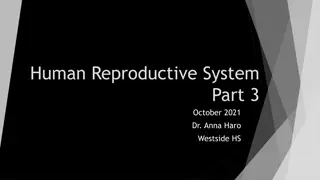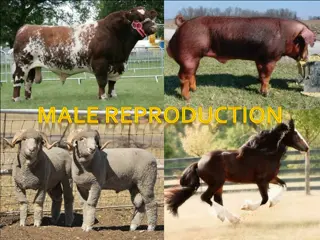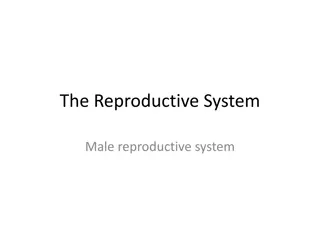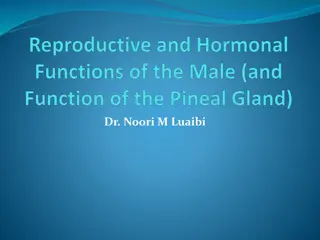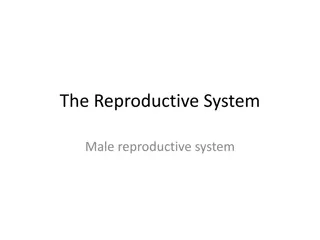
Spermatogenesis: Process, Location, and Duration
Spermatogenesis is the complex process through which mature spermatozoa develop from germ cells in the testes, crucial for sexual reproduction. Learn about the stages, duration, and location of spermatogenesis in humans.
Download Presentation

Please find below an Image/Link to download the presentation.
The content on the website is provided AS IS for your information and personal use only. It may not be sold, licensed, or shared on other websites without obtaining consent from the author. If you encounter any issues during the download, it is possible that the publisher has removed the file from their server.
You are allowed to download the files provided on this website for personal or commercial use, subject to the condition that they are used lawfully. All files are the property of their respective owners.
The content on the website is provided AS IS for your information and personal use only. It may not be sold, licensed, or shared on other websites without obtaining consent from the author.
E N D
Presentation Transcript
StudyMafia.Org Spermatogenesis Submitted To: Studymafia.org Studymafia.org Submitted By:
Table Contents Definition Introduction Process of Spermatogenesis Location in Humans Duration of Spermatogenesis Stages of Spermatogenesis Influencing Factors Spermatogenesis Flowchart Conclusion 2
Definition Spermatogenesis is the process by which haploid spermatozoa develop from germ cells in the seminiferous tubules of the testis. 3
Introduction This process starts with the mitotic division of the stem cells located close to the basement membrane of the tubules. These cells are called spermatogonial stem cells. The mitotic division of these produces two types of cells. Type A cells replenish the stem cells, and type B cells differentiate into primary spermatocytes. The primary spermatocyte divides meiotically (Meiosis I) into two secondary spermatocytes; each secondary 4
Purpose of Spermatogenesis Spermatogenesis produces mature male gametes, commonly called sperm but more specifically known as spermatozoa, which are able to fertilize the counterpart female gamete, the oocyte, during conception to produce a single-celled individual known as a zygote. This is the cornerstone of sexual reproduction and involves the two gametes both contributing half the normal set of chromosomes (haploid) to result in a chromosomally normal (diploid) zygote. 6
Location in humans Spermatogenesis takes place within several structures of the male reproductive system. The initial stages occur within the testes and progress to the epididymis where the developing gametes mature and are stored until ejaculation. The seminiferous tubules of the testes are the starting point for the process, where spermatogonial stem cells adjacent to the inner tubule wall divide in a centripetal direction beginning at the walls and proceeding into the innermost part, or lumen to produce immature sperm. Maturation occurs in the epididymis. 7
Duration of Spermatogenesis For spermatogenesis is variously estimated as taking 74 days (according to tritium-labelled biopsies) and approximately 120 days (according to DNA clock measurements). Including the transport on ductal system, it takes 3 months. Testes produce 200 to 300 million spermatozoa daily. However, only about half or 100 million of these become viable sperm. humans, the entire process of 8
Stages of Spermatogenesis The entire process of spermatogenesis can be broken up into several distinct stages, each corresponding to a particular type of cell in humans. In the following table, ploidy, copy chromosome/chromatid counts are for one cell, generally prior to DNA synthesis and division (in G1 if applicable). The primary spermatocyte is arrested after DNA synthesis and prior to division. number and 9
Influencing factors The process of spermatogenesis is highly sensitive to fluctuations in the environment, particularly hormones and temperature. Testosterone is required in large local concentrations to maintain the process, which is achieved via the binding of testosterone by androgen binding protein present in the seminiferous tubules. Testosterone is produced by interstitial cells, also known as Leydig cells, which reside adjacent to the seminiferous tubules. 11
Conclusion Spermatogenesis is a long and orderly process through which spermatozoa are produced within seminiferous tubules and is divided into spermatocytogenesis (mitosis), meiosis, and spermiogenesis (differentiation without division). 13
References Google.com Wikipedia.org Studymafia.org Slidespanda.com
Thanks To StudyMafia.org











